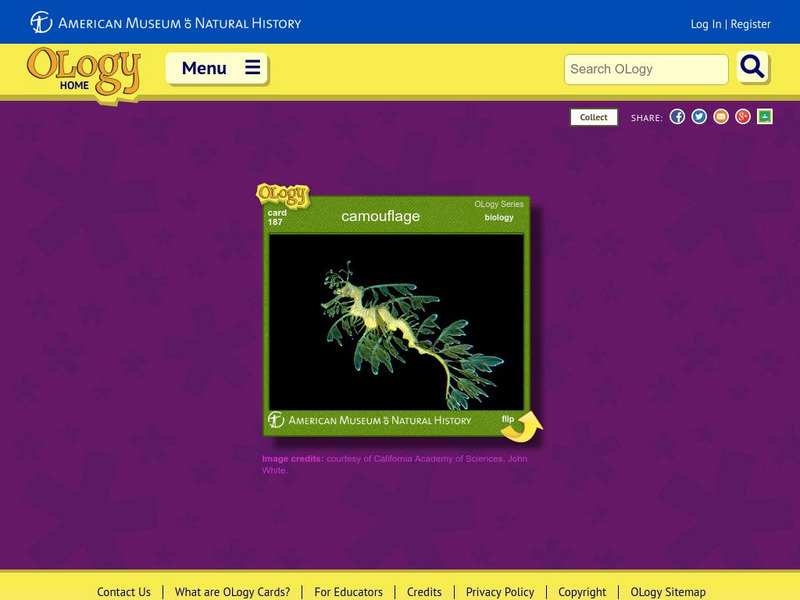University of Pennsylvania
Evolution by Natural Selection
A diagram, data table, and reading passage top this resource. Through it, biology beginners are introduced to the concept of natural selection. They answer some questions and then participate in a simulation using fabric as a habitat and...
American Museum of Natural History
What's This? Colorful Creatures
An online resource shows learners some species that are very good at using their camouflage as well as other ways species use their coloring for survival. Interactive and digital, the lesson is perfect as a remote learning resource.
CK-12 Foundation
Natural Selection: Peppered Moths
Can human activity influence the colors of moths? The simulation explains how pollution changed the color of tree bark, which led to the survival of a different variation of moths. It also discusses the shift back as air quality improves.
CK-12 Foundation
Natural Selection: Natural Disasters
Can natural disasters alter natural selection? The interactive explores this concept with mice living through a forest fire. As the environment changes, the camouflage also changes. How does this one disaster impact future generations?
Umaine Museum of Art
Bony Fish Anatomy Worksheet
Take time to appreciate the beauty in the anatomy of animals with this cross-curricular art and science activity. After viewing examples of fish-themed artwork, children complete the included worksheet by labeling the...
Berkshire Museum
Camouflage!: Collecting Data and Concealing Color
Help young scholars see the important role camouflage plays in the survival of animals with a fun science lesson. Starting with an outdoor activity, children take on the role of hungry birds as they search for worms represented by...
Curated OER
Orienteering
Young scholars acquaint with co-participants and identify the practice basic compass functions and orienteering procedures. They also work together to solve a small challenge. Students then identify how the challenge of orienteering...
Curated OER
Hide In Plain Sight
Students view video clips and use the Internet to look for hidden animals. They then use the Internet to print out animal shapes and color them. They create environments on construction paper in which their animals can hide.
Curated OER
Why are Polar Bears White
Students explore camouflage as they study polar bears and their habitat. They study how color can help animals in the wild.
Curated OER
TIDES
Second graders are taught the concept of camouflage through the game hide and seek. They view photographs of camouflaged animals on the TIDES website. Students create a poster that camouflages a particular animal based on what they have...
Curated OER
Camouflage, Protection, & Adaptations—Who am I?
Students explore ocean animal adaptations. In this animal adaptations instructional activity, students examine how different ocean animals use adaptations other than camouflage to protect themselves.
Curated OER
Animal Camouflage 1
Second graders work in groups and they are asked to line up on either side of the board. They are explained that on the teachers instruction, one student at a time runs to the marked area and brings back the first worm they see. Students...
Curated OER
Biodiversity in Illinois-Pond Habitats
Second graders construct a pond habitat in the classroom using a small swimming pool partially filled with water, real cattails, a tree log adjoining, and plastic animal life appropriate to a pond setting. They examine the frog in detail...
Curated OER
Hide and Seek
Young scholars examine animals that use camouflage and discuss why they use it. They create drawing of an imaginary animal that uses camouflage to hide in the classroom and identify the adaptations that would allow it to hide effectively.
Curated OER
Natural Selection
Students construct a working definition of the word "evolution," and list the key points of Darwin's theory of natural selection. They create paper moths to help them explain the importance of camouflage and how it relates to natural...
Curated OER
Animals Abound
Students explore the world of mammals, birds, and fish to compare and contrast their habitats, adaptations, and camouflages. Through research, musical experiences, and hands-on activities, the lives and adventures of these animals are...
Exploratorium
Exploratorium: Frogs, a Disappearing Act
At this site students can read about how frogs camouflage to avoid predators. There is an interactive exhibit too! (Must have the Shockwave plug-in to see animation.)
Other
M. Tevfik Dorak, m.d., ph.d.: Mimicry
Describes what mimicry is. Describes the different kinds of mimicry found and by whom.
American Museum of Natural History
American Museum of Natural History: Camouflage O Logy Card
Flip this interactive OLogy card to start learning about camouflage and the role it plays in helping animals survive.




















